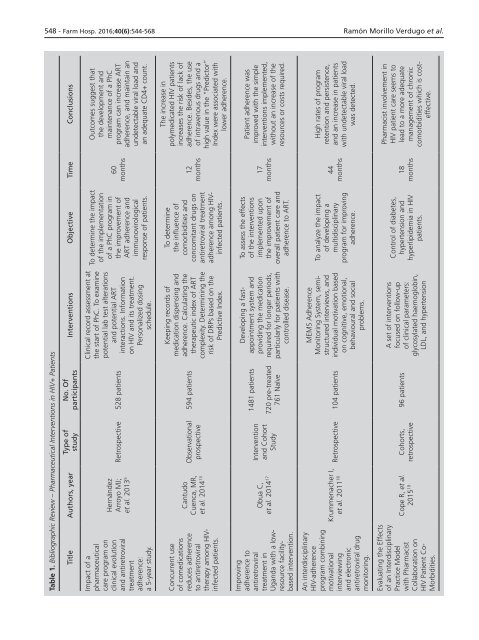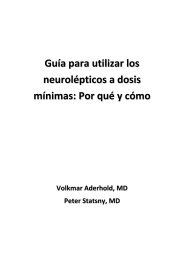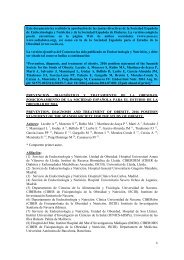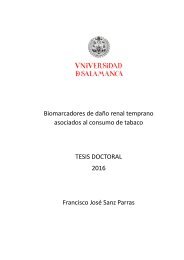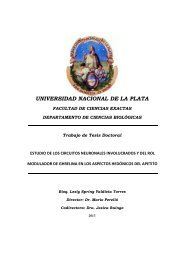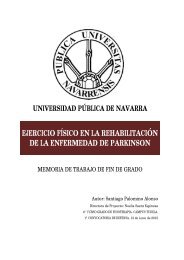Noviembre-Diciembre
156_v40n6(1)
156_v40n6(1)
Create successful ePaper yourself
Turn your PDF publications into a flip-book with our unique Google optimized e-Paper software.
548 - Farm Hosp. 2016;40(6):544-568 Ramón Morillo Verdugo et al.<br />
Table 1. Bibliographic Review – Pharmaceutical Interventions in HIV+ Patients<br />
Title Authors, year<br />
Type of<br />
study<br />
No. Of<br />
participants<br />
Interventions Objective Time Conclusions<br />
Impact of a<br />
pharmaceutical<br />
care program on<br />
clinical evolution<br />
and antiretroviral<br />
treatment<br />
adherence:<br />
a 5-year study.<br />
Hernández<br />
Arroyo MJ; Retrospective 528 patients<br />
et al. 2013 5<br />
Clinical record assessment at<br />
the start of PhC. To examine<br />
potential lab test alterations<br />
and potential ART<br />
interactions. Information<br />
on HIV and its treatment.<br />
Personalized dosing<br />
schedule.<br />
To determine the impact<br />
of the implementation<br />
of a PhC program in<br />
the improvement of<br />
ART adherence and<br />
immunovirological<br />
response of patients.<br />
60<br />
months<br />
Outcomes suggest that<br />
the development and<br />
maintenance of a PhC<br />
program can increase ART<br />
adherence, and maintain an<br />
undetectable viral load and<br />
an adequate CD4+ count.<br />
Concurrent use<br />
of comedications<br />
reduces adherence<br />
to antiretroviral<br />
therapy among HIVinfected<br />
patients.<br />
Cantudo<br />
Observational<br />
Cuenca, MR,<br />
prospective<br />
et al. 2014 13<br />
594 patients<br />
Keeping records of<br />
medication dispensing and<br />
adherence. Calculating the<br />
therapeutic index of ART<br />
complexity. Determining the<br />
risk of DRPs based on the<br />
Predictive Index.<br />
To determine<br />
the influence of<br />
comorbidities and<br />
concomitant drugs on<br />
antiretroviral treatment<br />
adherence among HIVinfected<br />
patients.<br />
12<br />
months<br />
The increase in<br />
polymedicated HIV patients<br />
increases the risk of lack of<br />
adherence. Besides, the use<br />
of intravenous drugs and a<br />
high value in the “Predictor”<br />
Index were associated with<br />
lower adherence.<br />
Improving<br />
adherence to<br />
antiretroviral<br />
treatment in<br />
Uganda with a lowresource<br />
facilitybased<br />
intervention.<br />
Intervention<br />
Obua C,<br />
and Cohort<br />
et al. 2014 17 Study<br />
1481 patients<br />
720 pre-treated<br />
761 Naïve<br />
Developing a fastappointment<br />
system and<br />
providing the medication<br />
required for longer periods,<br />
particularly for patients with<br />
controlled disease.<br />
To assess the effects<br />
of the interventions<br />
implemented upon<br />
the improvement of<br />
overall patient care and<br />
adherence to ART.<br />
17<br />
months<br />
Patient adherence was<br />
improved with the simple<br />
interventions implemented,<br />
without an increase of the<br />
resources or costs required.<br />
An interdisciplinary<br />
HIV-adherence<br />
program combining<br />
motivational<br />
interviewing<br />
and electronic<br />
antiretroviral drug<br />
monitoring.<br />
Krummenacher I,<br />
Retrospective 104 patients<br />
et al. 2011 18<br />
MEMS Adherence<br />
Monitoring System, semistructured<br />
interviews, and<br />
individual motivation based<br />
on cognitive, emotional,<br />
behavioural and social<br />
problems.<br />
To analyze the impact<br />
of developing a<br />
multidisciplinary<br />
program for improving<br />
adherence.<br />
44<br />
months<br />
High rates of program<br />
retention and persistence,<br />
and an increase in patients<br />
with undetectable viral load<br />
was detected.<br />
Evaluating the Effects<br />
of an Interdisciplinary<br />
Practice Model<br />
with Pharmacist<br />
Collaboration on<br />
HIV Patient Co-<br />
Morbidities.<br />
Cope R, et al. Cohorts,<br />
2015 19 retrospective<br />
96 patients<br />
A set of interventions<br />
focused on follow-up<br />
of clinical parameters:<br />
glycosylated haemoglobin,<br />
LDL, and hypertension<br />
Control of diabetes,<br />
hypertension and<br />
hyperlipidemia in HIV<br />
patients.<br />
18<br />
months<br />
Pharmacist involvement in<br />
HIV patient care seems to<br />
lead to a more adequate<br />
management of chronic<br />
comorbidities which is costeffective.


